Featured foods : Broccoli, Cauliflower, Cabbage
Introduction
In this article we will focus on several cruciferous vegetables that are part of the brassicaceae family. Two of the main phytonutrients contained in these vegetables are Sulforaphane and Indole-3-Carbinol which we will discuss how they block the progression of cancer, and we will look in detail how they affect cancer prostate cells.
Glucosinolates

Glucosinolates are a class of secondary metabolites which are nitrogen and sulphur substances found almost exclusively in the Brassicaceae family of plants including broccoli, cauliflower, brussel sprouts, kale, cabbage, garden cress, bok choy, radish which are basically the cruciferous vegetables ( Cruciferae ). The glucosinolates compounds are stable unless the plant becomes damaged when they can emit volatile mustard oil glycosides(glucobrassicin for example) and other degradation products like isothiocyanates, nitriles etc. Isothiocyanates are involved in the plants defense system against pathogenic bacteria and herbivores, but in humans this compound provides cancer protection. To also protect itself against herbivores, once the animal starts to munch on the leaves, these plants can emit cyanogenic glycosides, which is essentially a colourless toxic gas to deter the invader, and like the emission of mustard oil ( if you cut fresh radish you are able to smell it), it is a hydrolyzing enzyme thioglucosidase that comes into contact with the substrate once the plant becomes damaged that is responsible for the emission. Glucosinolates yield a pungent sulphur containing amino acid derived aglycone which we discussed in previous articles on phenols, but in this case it is glucobrassicins, and isothiocyanates which are oily substances whereas glucosinolates are water soluble. The glucosinolates are not to dissimilar to the cysteine sulfoxides found in garlic (allium sativum). These important phytonutrients exist in all cruciferous vegetables as shown from the charts below:
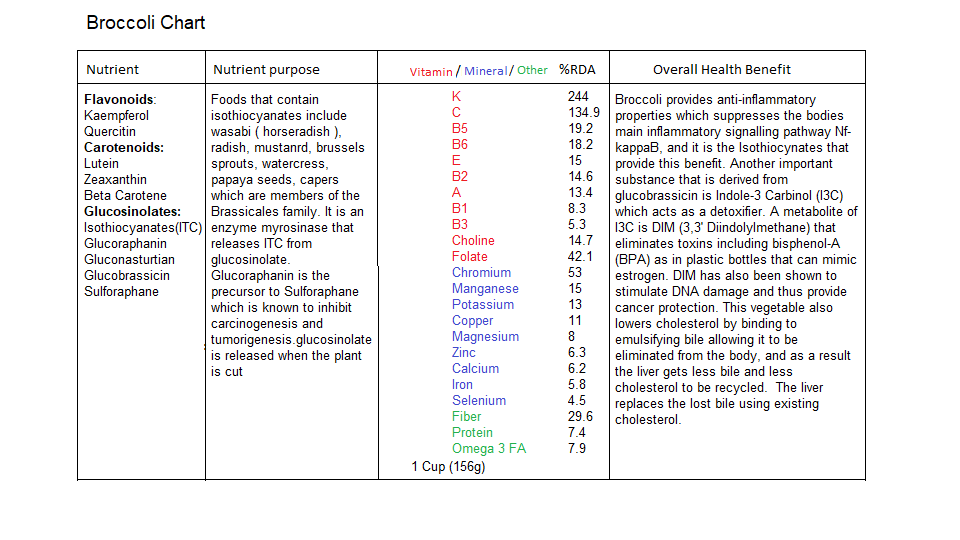
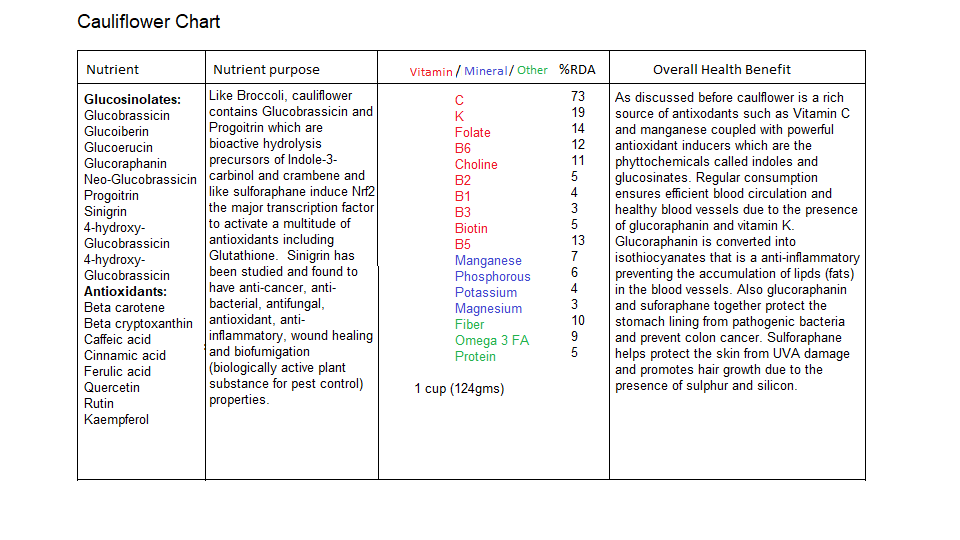
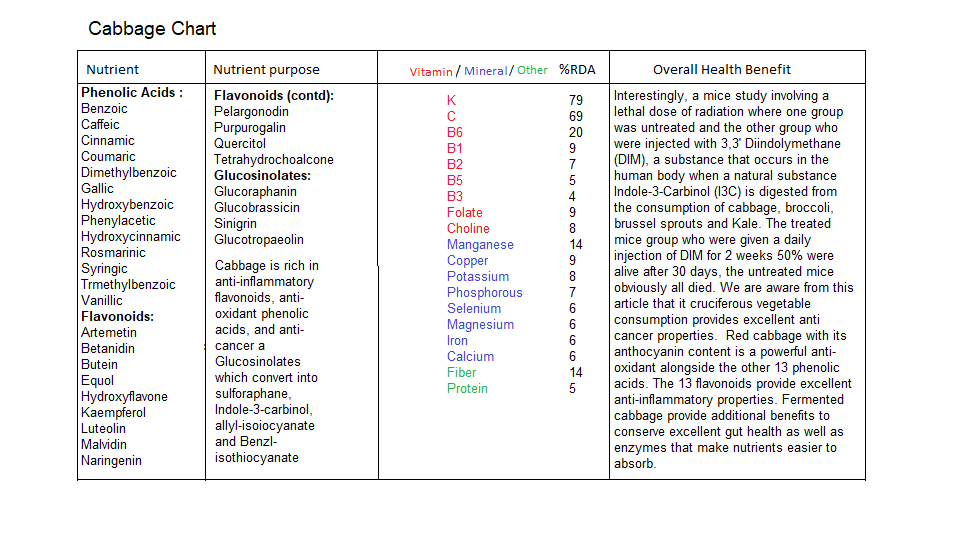
NAD/NADH/NADPH relationship and Sulforaphane induction

Zhang et al in 1992 reported that sulforaphane, a natural phytochemical in Broccoli is a major inducer of anticarcinogenic protective enzymes responsible for xenobiotic ( anything foreign to the body including carcinogens, toxins, drugs etc) metabolism which accelerates their disposal from the body. Sulforaphane induces these Phase II detox enzymes including quinone reductase (NADPH) and Glutathione S-Transferase. If you have read the articles on the 90 essential nutrients Part 6 Vitamin E we discussed the NAD/NADH/NADPH relationship. Nicotinamide Adenine Dinucleotide (NAD) is the cofactor ( or Coenzyme) for Niacin and Nicotinamide Adenine Dinucleotide (NAD) is derived from the amino acid Tryptophan, that relies on Riboflavin (FAD) for its synthesis and NAD is used for all fuel to energy conversions for cellular energy production. In addition FAD is also used to synthesise the bodies most powerful antioxidant Glutathione in conjunction with the enzyme Glutathione reductase. Both NADH and NADPH are important electron carriers during the antioxidant activity of electron exchange. The role of NADH is used in catabolic reactions ( from previous articles we explained that Catabolism is the breaking down of substances to release energy) while NADPH is used for anabolic reactions ( Anabolism is the formation of biological building blocks like proteins and nucleic acids ). In terms of antioxidant activity, NAD is the oxidised form while NADH is the reduced form. Similarly NADP is the oxidised form while NADPH is the reduced form. From cellular function its primary task is to generate energy so the NAD/NADH ratio that releases energy is kept high while the NADP/NADPH ratio that consumes energy is kept low. Below is the relationship in terms of the cellular antioxidant network:
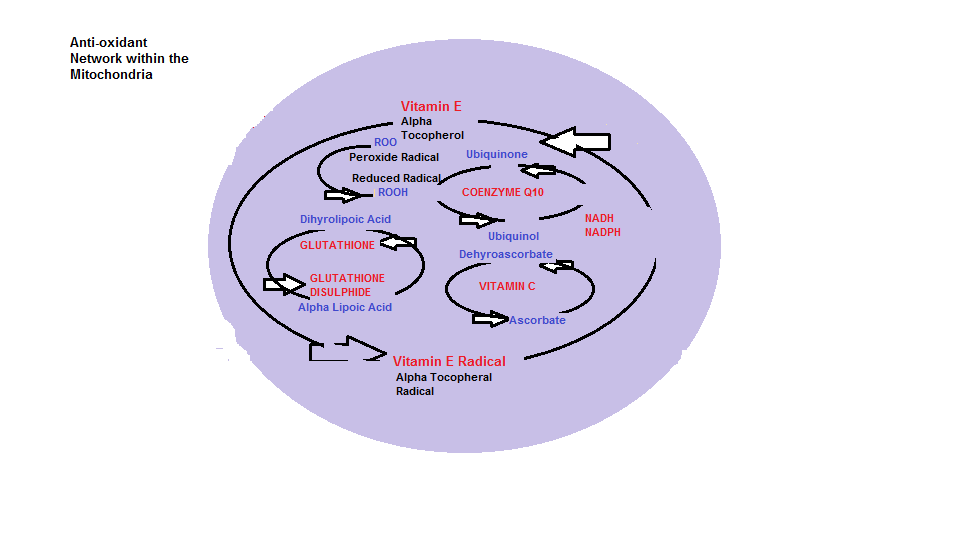
Sulforaphane and the prostate
Sulforaphane exists in Broccoli as the glucosinolate, glucoraphanin, which is converted by the plant enzyme myrosinase and when ingested by humans it reaches a plasma concentration peak within 2 hours of consumption and eventually reaches the prostate causing changes in cellular processes. This was confirmed in a study by Clarke et al called ‘Multi targeted prevention of cancer by Sulforaphane’ 2008 that discussed isothiocyanates in Broccoli, Brussels sprouts, cauliflower and cabbage that lowers overall cancer risk including colon and prostate. Specifically, in the prostate gland the intracellular signalling pathway P13/AKT/mTOR pathway regulates the cell cycle involving cellular quiescence ( a non proliferation stage), proliferation, cancer and longevity. This biological pathway promotes proliferation and growth rather than cellular differentiation on adult stem cells, so you don’t want this pathway to be over stimulated causing uncontrolled growth and cancer eruption. Scientific research has uncovered particular stimulants of this pathway that include EGF (Epidermal growth factor), which in turn, is stimulated by testosterone and regulated by iodine. In addition, Shh ( Sonic Hedgehog) protein involved in vertebrate development of an embryo and in the adult, controls cell division of the stem cell, IGF 1(Insulin like growth Factor) a fat burning hormone made by the liver and triggered by GH (Growth Hormone), which is made by the pituitary and used to build cartilage and collagen. IGF1 provides the mechanism to fuel the body when the stomach is empty during sleep for example or between meals, while Insulin is used to control body fuel while eating.
The Bodies cellular Master Regulator – AMPK
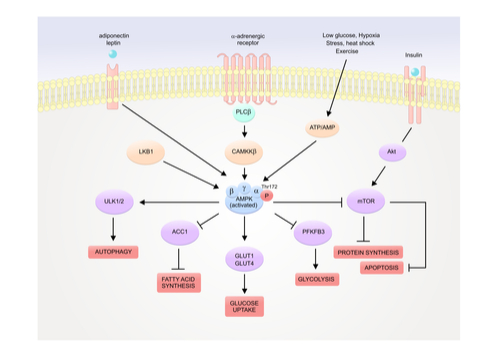
AMPK ( Adenosine Monophosphate-Activated Protein Kinase ) that most people have never heard of, is a vital enzyme made from 3 proteins found in all cells that regulate how the cells process energy. This seemingly insignificant enzyme stimulates hepatic fatty acid oxidation which is critical when there is shortage of food, so under these conditions starvation initiates a series of metabolic adaptations to maintain production and delivery of nutrients to essential organs, tissues and cells. Coordinated chiefly by the liver, which liberates glucose from storage, manufactures glucose, and produces ketones as an alternative energy source, especially for high oxidative tissues in the brain. In effect the liver is converted into a fat burner so fatty acid oxidation is essential by supplying the carbon substrate for ketogenesis, since free fatty acids are released from the breakdown of stored triglycerides. Skeletal muscle fatty acid oxidation is effected (increased) by exercise and starvation conditions, whereas excessive plasma insulin as in Hyperinsulinemia limits the availability of free fatty acid to the muscle. However AMPK stimulates glucose uptake in the cells, while modulating insulin secretion by pancreatic beta cells. It is also involved in Lipogenesis, triglyceride synthesis, adipocyte lipolysis and lipogenesis. AMPK activates autophagy ( cell recycling ), mitochondrial biogenesis (increasing ATP energy production to serve the host needs for additional energy), and antioxidant defenses. It is important to say that AMPK ( it also decides host longevity) is fully activated in youth to prevent obesity and diabetes, but as we age its activation decreases unless it gets reactivated.
The cause of AMPK activation decline and what to do about it
What causes this decline of activation of AMPK ?…wait for it..abdominal obesity, insulin resistance, High LDL particles, accumulation of cellular debris, increased cellular stress, unfavourable epigenetic switching, high triglycerides, mitochondrial dysfunction, chronic inflammation, which are all diet related one way or another. Natural nutritional compounds can reactivate AMPK including Resveratrol ( grapes ), Alpha Lipoic Acid (Spinach, brocolli, potatoes, tomatoes, brussel sprouts, carrots, beets, organ meats) and Indole-3-Carbinol (spinach, broccoli,potatoes, tomatoes, brussel sprouts,carrots, beets, organ meats such as liver), rice bran, EGCG a phytochemical found in green tea, Curcumin ( Turmeric), Fish or krill oil and Quercetin ( see broccoli and cauliflower chart ). Conventional medicine inform us that their diabetes drug Metformin also activate AMPK, but avoid this and stick with something more natural.
Prostate cancer potential triggers

For the past 75 years focus on hormonal triggers for prostate cancer centred around Androgens, but the focus shifted toward estrogen as being the possible mechanism of carcinogenesis. From my article on HRT I explained that, of the 3 estrogens that are naturally produced in the body Estradiol drives growth and development, acting as a growth hormone for tissue relating to the reproductive system, but as the levels of estrogen increase in the male as they get older it is conceivable that it can drive aberrant growth in the prostate. Furthermore, estradiol has been classified as a carcinogen by the International agency for research on cancer, and laboratory research isolating prostate progenitor ( next stage from stem cells) cells, and found that these cells are direct estrogen targets, since they exhibit a proliferative response to estradiol, and estrogen may even regulate cellular self renewal in the prostate. Prostate abnormality, and hence hormonal imbalance has also been suggested to be induced in the offspring of mothers who used some type of synthetic estrogen supplement such as diethylstilbestrol.
Steroid hormones
Let us clarify the difference between steroid hormones and hormones. Hormones are produced by the endocrine glands in the body such as the thyroid, adrenals etc and they are signalling molecules released into the blood and travel to target organs to affect specific responses from specific cells. For example, adrenaline and insulin which assists in the adjustment of the body during sudden stress, by increasing the pulse rate and increasing food to energy conversion, to drive muscle movement, and notifying cells for the uptake of glucose from the bloodstream respectively. Steroid hormones on the other hand drive changes within the cell causing RNA transcription for the production of specific proteins. Steroid hormones are produced by the adrenal glands and the reproductive glands such as the testes and ovaries. Steroid hormones like aldosterone produced by the adrenals promote sodium and water absorption and regulate blood pressure, cortisol released as an anti-inflammatory and small amounts of testosterone and estrogen. The gonadal (testes/ovary) steroid hormones produce testosterone and estrogen as well as progesterone ( from the ovary) for the production and maintenance of the uterine lining during pregnancy. The body requires cholesterol as the raw material to make these hormones and subsequent conversions are shown in the diagram below:
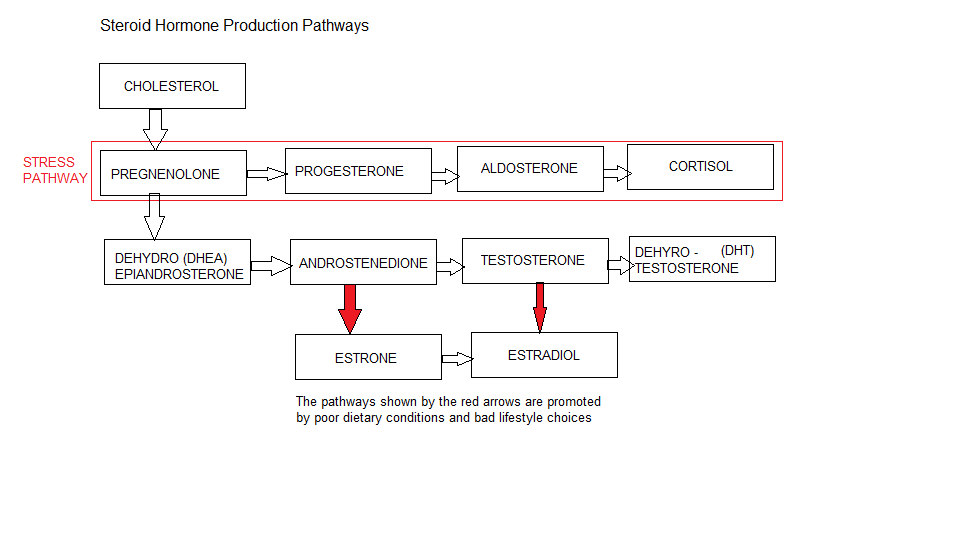 If the host body is not being fuelled correctly, and is nutrient deficient/toxic then the production of required steroid hormone such as in the prostate promotes the DHEA pathway to divert to the manufacture of excess estrogen products such as estrone and estradiol. Since, up until recently, based on the old theory of androgen driven prostate cancer, most drugs that treat Benign Prostatic Hyperplasia (BPH) which is the overgrowth of prostate tissue, target DHT androgen but as you can see in the diagram above, the growth pathway diverts toward estrogen production, so the drug target is wrong, since estradiol acts as a growth hormone within the human reproductive system
If the host body is not being fuelled correctly, and is nutrient deficient/toxic then the production of required steroid hormone such as in the prostate promotes the DHEA pathway to divert to the manufacture of excess estrogen products such as estrone and estradiol. Since, up until recently, based on the old theory of androgen driven prostate cancer, most drugs that treat Benign Prostatic Hyperplasia (BPH) which is the overgrowth of prostate tissue, target DHT androgen but as you can see in the diagram above, the growth pathway diverts toward estrogen production, so the drug target is wrong, since estradiol acts as a growth hormone within the human reproductive system
The prostate cancer cell inhibition targets
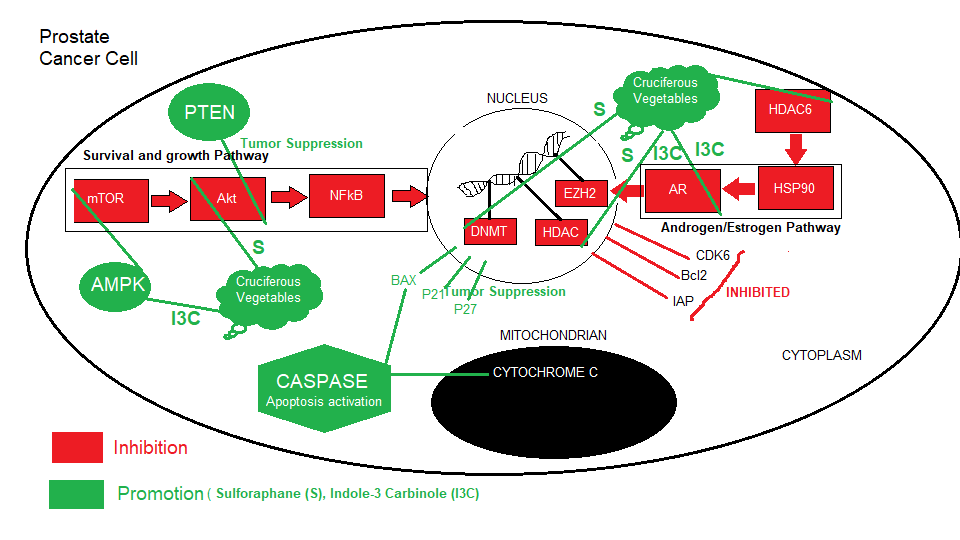
Androgen/Estrogen Pathway
The diagram above is a little busy but it displays how powerful cruciferous vegetables are in tumor suppression which applies to all cancers. One must never forget that a cancer cell is a normal cell that remains undifferentiated and dysregulated, so all of the enzymatic mechanisms shown in the diagram is the same as in a normal cell. We know that the trigger for prostate cancer cells to proliferate is a hormonal imbalance, driven by a nutrient deficient/toxic lifestyle as depicted in the diagram ‘Steroid hormone production pathways’. If we follow the androgen signalling pathway HDAC6-HSP90-AR in the diagram above, we see HDAC6 ( Histone deacetylase), an enzyme that removes acetyl groups to allow histones to wrap the DNA tightly once it has been read. HSP90 is a molecular chaperone that regulates protein folding to define its biological function, which in this case it has none, but only to express cancer and AR (Androgen regulation) which regulates gene transcription. This pathway is the steroid hormone pathway where sulforaphane, and Indole-3-Carbinol in cruciferous vegetables such as broccoli, cauliflower, brussel sprouts, bok choy and green leafy vegetables including Kale, and collards inhibit at the HDAC6 stage.
Inside the cancer cell nucleus
DNMT ( DNA Methylation Transferase), an enzyme responsible for transferring methyl groups to DNA, and HDAC ( Histone Deacetylase ), an enzyme that removes acetyl groups, work together to methylate gene repression, regulating the epigenetic signature of cancer cells which are then inhibited by sulforaphane. In addition CDK6 (Cyclin Dependent Kinase) an enzyme involved in the cell cycle G1 to S1 phase *, is inhibited, disabling its ability to continue the cell cycle, and Bcl2 (B cell lymphoma 2) and IAP (Inhibitor of apoptosis) are both inhibited. Bax (Apoptosis activator is turned on to liberate cytochrome c from the mitochondria to activate Caspase (Cysteine Aspartic Protease) a family of enzymes that perform apoptosis. Both Tumor suppressor genes P21 and P27 are also expressed from the action of sulforaphane.
*You may remember in part 1 we described the cell cycle : Cells constantly monitor their cell cycle using Cyclin checkpoints which have particular binding sites and direct the enzymes CDKs ( Cyclin Dependent Kinase ) to perform their tasks which requires phosphorylation, regulating cell progression through the cell cycle. These checkpoints are referred to as G1,S,G2,M The cyclin gene expression is a 24 hours oscillatory process. The G1(restriction) checkpoint verifies DNA integrity, and if there is DNA damage, due to, say, lack of nutrients this biological process will decide upon DNA repair or just destroy the cell via apoptosis. This is performed by the induction of the P53 pathway (P53 is the bodies master tumor suppressor gene) that institutes Cell cycle Arrest, which is basically a stalled state until the cell cycle mechanism decides what to do. Each cycle is under a time constraint, so it needs to make a quick decision. If the DNA is repaired then it can then proceed to the S ( DNA replication) checkpoint phase and once DNA replication is complete it can then proceed to the G2 (growth) checkpoint.
Survival and growth pathway
MH Traka at al in 2010 showed that Akt signalling was attenuated in prostate tissue in response to long term consumption of sulforaphane rich broccoli by modulating the PTEN( Phosphatase and Tensin Homolog, a gene that instructs cells to stop dividing or self destruct – apoptosis) gene expression, basically turning this tumor suppressor gene on. We are also informed that Quercetin ( bioflavonoid found in apples,onions etc), Resveratrol (antioxidant found in dark skin grapes), and Curcumin ( active ingredient in Turmeric spice) can also reactivate PTEN. In addition, Sulforaphane can block the Akt/NFkB signalling pathway, inhibiting cancer cell growth. Since breast cancer is also triggered by hormonal imbalance, eating cruciferous vegetables regularly will have the same protective effect as in prostate cancer.
Conclusions
Cruciferous vegetables are a must to eat daily to maintain great health. To keep estrogen under control it is vital to consume these vegetables to avoid endocrine system problems with the thyroid, ovary, adrenals, liver. As we have discussed in detail, these vegetables are anti-carcinogenic..meaning daily consumption will protect you from cancer.
Check out the Previous Article in this series:
Check out other Articles in this series:
Nutrients in Food and their bodily purpose I (Phenols)
Nutrients in Food and their bodily purpose II (Lignans, Triterpenes, Phytosterols, Carotenoids & Fats)
Nutrients in Food and their bodily purpose III (Phenolic acids, sulphur, sulphides,sulphoxides )
Nutrients in Food and their bodily purpose V (Lipid distribution, absorbed fats, Criciferous Veg)
Nutrients in Food and their bodily purpose VI (Nutrients required for Liver Detox)
Nutrients in Food and their bodily purpose VII (Seeds & the Omega Fatty Acids)
Nutrients in Food and their bodily purpose VIII (Nutrients required for cellular energy production)
Nutrients in Food and their bodily purpose IX (Water I Properties and Body fluids)
Nutrients in Food and their bodily purpose X (Water II Cellular Hydration)
Nutrients in Food and their bodily purpose XI (Water III Fluid filtration, reabsorption, excretion)
Nutrients in Food and their bodily purpose XII (Water IV Blood pressure, Blood volume regulation)
Nutrients in Food and their bodily purpose XIII (Water V Body Fluid Dysfunction
Nutrients in Food and their bodily purpose XIV (Dental Nutrients)
Nutrients in Food and their bodily purpose XV (Nutrients involved in Methylation I)
Nutrients in Food and their bodily purpose XVI (Nutrients involved in Methylation II)
Nutrients in Food and their bodily purpose XVII (Nutrients involved in Methylation III)
Nutrients in Food and their bodily purpose XVIII (Nutrients involved in Methylation IV)
Nutrients in Food and their bodily purpose XIX (Methylation V and the Microbiota I)
Nutrients in Food and their bodily purpose XX (Methylation VI and the Microbiota II)
Nutrients in Food and their bodily purpose XXI (Superfoods: Wheatgrass)
Nutrients in Food and their bodily purpose XXII (Superfoods: Adaptogens)
Nutrients in Food and their bodily purpose XXIII (A look into our nutritional past Sir Robert McCarrison)
Nutrients in Food and their bodily purpose XXIV (Pregnancy: Nature vs Nurture vs Nutrition)
References/Acknowledgments :
- Dehydroepiandrosterone (DHEA), Wikipedia
- Glucobrassicin 2016 Sciencedirect
- Sinigrin and its therapeutic effects Mazumder at al NCBI 2016
- Broccoli / Cauliflower/Cabbage The world’s healthiest foods
- 20 Amazing benefits of cauliflower Organic facts 2018
- The physiological importance of Glucosinolates on plant response to abiotic stress in Brassica Maria del carmen martinez Ballesta 213 NCBI
- A major inducer of anticarcinogenic protective enzymes from Broccoli:isolation and elucidation Zhang et al 1992 NCBI
- Multi targeted prevention of cancer by Sulforaphane Clarke et al 2008 NCBI
- Hepatic fatty acid oxidation restrain systemic catabolism during starvation Jien Lee at al 2016 NCBI
- Fatty acid oxidation in human skeletal muscle Michael Jensen 2002 NCBI
- AMPK life extension magazine James Robbins
- How Steroid Hormones work Regina Bailey 2017 ThoughtCo
- Phytochemicals from cruciferous vegetables, epigenetics, and prostate cancer prevention Gregory Watson et al 2013 NCBI
- How to turn on cancer fighting genes Dr Nalini Chilkov Huffpost blog 2017
- The dietary isothiocyanate sulforaphane modulates gene expression and alternative gene splicing in a PTEN null preclinical murine model of prostate cancer MH Traka et al 2010 NCBI
Author: Eric Malouin